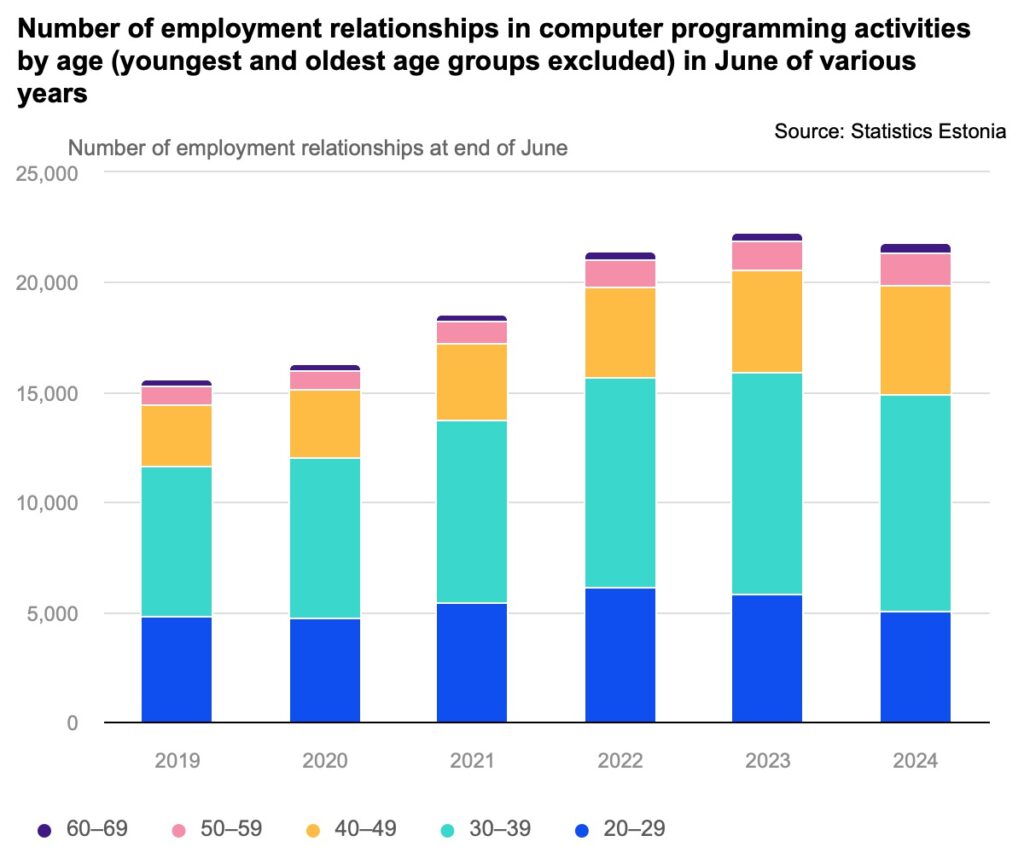Over the past year and a half, fewer young people aged 20-29 have been working in both the broader information and communication sector and the more specific field of computer programming, according to Statistics Estonia.
While in previous years the computer programming sector grew mainly because of young people, their numbers fell last year, according to the country’s official statistics agency’s short-term labour market survey.
Over the past decade, the information and communication sector has been an exemplary performer on the Estonian labour market, with the highest wages, growth in the number of employees even in the midst of crises, the greatest shortage of skilled workers and the highest growth ambitions, according to employers.
However, data from the employment register show that the number of employment relationships in the information and communication sector has fallen significantly over the last one and a half years. In June 2024, there were around 36,000 persons employed in this sector. More than half of them – 22,000 – are registered under computer programming, consultancy and related activities.
The largest number of new jobs to be created in the information and communications sector between 2019 and 2023 will be in computer programming, consultancy and related activities – 7,700. However, 600 of these jobs have disappeared in the past year. There have been smaller changes in the other sectors, but almost all of them have declined over the past year.

Young programmers being replaced by middle-aged ones
Kadri Rootalu, a data scientist at Statistics Estonia, said the biggest changes in computer programming have been among young people.
“While in the past the number of computer programming jobs grew because of younger workers, this growth has slowed over the past year and the number of young workers in the 20-29 age group in this field has declined,” Rootalu said.
For example, in June 2022 there were 6,130 young people aged 20-29 working in computer programming. By the end of June 2024, the number of young workers will have fallen to 5,070. However, the number of people aged 40 and over working in this field has increased. In 2022, there were 5,720 people aged 40-69 working in computer programming, rising to 6,880 in June this year.

In computer programming, the number of young professionals – software developers, application programmers, system analysts and administrators, etc. – has decreased the most. In June 2023, there were 3,920 young people working as computer programming professionals, while in June 2024 there were only 3,370 people aged 20-29 working as computer programming professionals. In the other age groups, the decline in the number of professionals was smaller, and in the 40-59 age group the number of professionals increased.

What is behind the change?
According to Rootalu, the decline in the share of young people in information and communication and computer programming is partly in line with the changing composition of the population. In 2019, the number of 20-29 year olds in Estonia will be 153,000, but by 1 January 2024 it will be 136,000.
In the 40–49 age group, however, the number of people has increased by more than 10,000 over these years.
“We can assume that young people who started in the field of computer programming in earlier years have simply got older,” Rootalu said.
However, the question remains unanswered as to why the number of young people employed in programming has fallen in the last two years in particular, when the proportion of young people in the population as a whole has been falling for some time.
“There is nothing that stands out about those who have left the world of computer programming other than the fact that they are young people. About two-thirds of them are Estonian citizens and half of them have a university degree,” Rootalu added.


Tere Sten, Since the drop you note is more recent, it might be due to the trend that portrays that companies no longer need wise people serving in IT, instead new AI can replace the people? I still hope to have an IT Development Team located in Estonia. I seek interest in my vision which would greatly improve the reliability of relying on computers by leveraging the correct administration solution of Desired End-State Software Distribution. I contacted one Estonian V.C. seeking their interest. They declined, stating: “Not risky enough. Too sure to work.” With all of the problems this world faces that could be avoided by using this strategy, and that type of reaction from a V.C…. !!! Ma ei tea… Ma ei tea… I keep asking / keep seeking / keep knocking on doors… My response to AI…. it is not Artificial Intelligence the world needs, rather the world needs Genuine Intelligence, and that cannot come artificially.